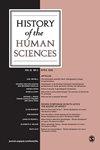Psychedelic psychodrama: Raising and expanding consciousness in Jane Arden’s The Other Side of the Underneath (1973)
IF 0.8
2区 历史学
Q2 HISTORY & PHILOSOPHY OF SCIENCE
引用次数: 2
Abstract
Jane Arden’s debut feature film The Other Side of the Underneath (1973) is an adaptation of the radical feminist play A New Communion for Freaks, Prophets and Witches (1971). In both the play and the later film, the all-female cast re-enact personal and archetypal situations using autobiographical material, which was collectively gathered from group therapy sessions led by the director. Psychedelic drugs were also consumed during the group therapy sessions. In this article, I will situate Arden’s distinct approach to performance in the film within the framework of psychodrama, focusing specifically on the role that psychedelic drugs play in unleashing performers’ repressed feelings of trauma, rage, and desire; these emotions are harnessed into a dynamic mode of performance that amplifies the cathartic possibilities of women’s speech. The film’s heady brew of radical feminist politics, group therapy, and countercultural self-actualisation is both challenging and contentious. I argue that Arden’s pursuit of consciousness liberation through psychodrama and psychedelics—in other words, through ‘raising’ and ‘expanding’ consciousness—is best understood as a concerted attempt to align countercultural and radical feminist tactics for unravelling repressive forms of social conditioning.迷幻心理剧:简·阿登《地下的另一面》(1973)中意识的提升与拓展
简·阿登的处女作《地下世界的另一面》(1973年)改编自激进女权主义戏剧《怪胎、先知和女巫的新社区》(1971年)。在这部剧和后来的电影中,所有女性演员都使用自传体材料重新演绎了个人和原型场景,这些材料是从导演领导的集体治疗会议中集体收集的。在小组治疗期间也服用了迷幻药。在这篇文章中,我将把阿登在电影中独特的表演方式置于心理剧的框架内,特别关注迷幻药在释放表演者压抑的创伤、愤怒和欲望方面所扮演的角色;这些情绪被运用到一种动态的表演模式中,放大了女性演讲的宣泄可能性。这部电影融合了激进的女权主义政治、团体治疗和反文化的自我实现,既有挑战性,也有争议。我认为,阿登通过心理剧和迷幻药——换句话说,通过“提高”和“扩大”意识——追求意识解放,最好被理解为一种协同努力,将反文化和激进的女权主义策略结合起来,以瓦解压制性的社会条件。
本文章由计算机程序翻译,如有差异,请以英文原文为准。
求助全文
约1分钟内获得全文
求助全文
来源期刊

History of the Human Sciences
综合性期刊-科学史与科学哲学
CiteScore
1.60
自引率
11.10%
发文量
31
审稿时长
>12 weeks
期刊介绍:
History of the Human Sciences aims to expand our understanding of the human world through a broad interdisciplinary approach. The journal will bring you critical articles from sociology, psychology, anthropology and politics, and link their interests with those of philosophy, literary criticism, art history, linguistics, psychoanalysis, aesthetics and law.
 求助内容:
求助内容: 应助结果提醒方式:
应助结果提醒方式:


